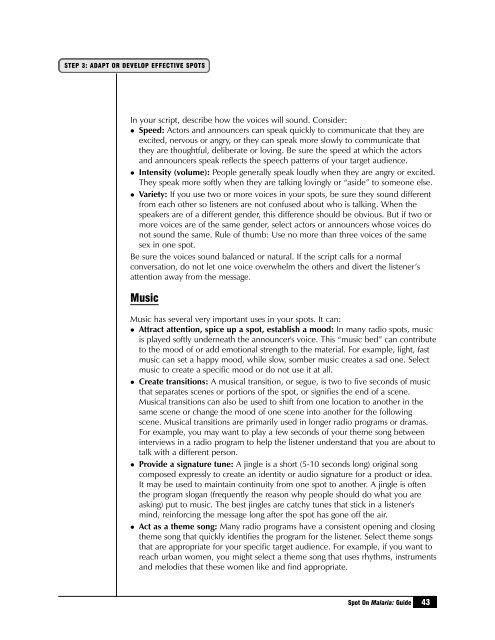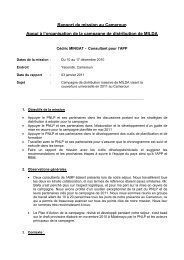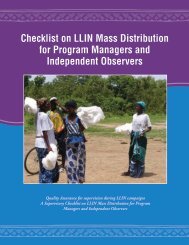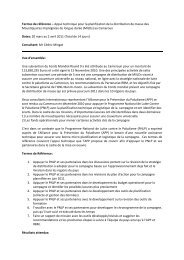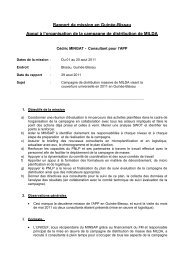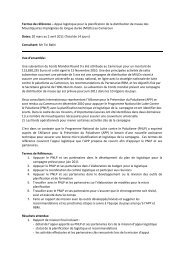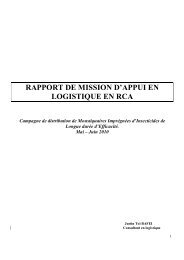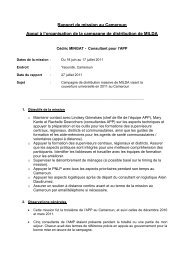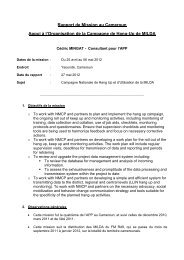Spots - Roll Back Malaria
Spots - Roll Back Malaria
Spots - Roll Back Malaria
- No tags were found...
You also want an ePaper? Increase the reach of your titles
YUMPU automatically turns print PDFs into web optimized ePapers that Google loves.
STEP 3: ADAPT OR DEVELOP EFFECTIVE SPOTSIn your script, describe how the voices will sound. Consider:• Speed: Actors and announcers can speak quickly to communicate that they areexcited, nervous or angry, or they can speak more slowly to communicate thatthey are thoughtful, deliberate or loving. Be sure the speed at which the actorsand announcers speak reflects the speech patterns of your target audience.• Intensity (volume): People generally speak loudly when they are angry or excited.They speak more softly when they are talking lovingly or “aside” to someone else.• Variety: If you use two or more voices in your spots, be sure they sound differentfrom each other so listeners are not confused about who is talking. When thespeakers are of a different gender, this difference should be obvious. But if two ormore voices are of the same gender, select actors or announcers whose voices donot sound the same. Rule of thumb: Use no more than three voices of the samesex in one spot.Be sure the voices sound balanced or natural. If the script calls for a normalconversation, do not let one voice overwhelm the others and divert the listener’sattention away from the message.MusicMusic has several very important uses in your spots. It can:• Attract attention, spice up a spot, establish a mood: In many radio spots, musicis played softly underneath the announcer's voice. This “music bed” can contributeto the mood of or add emotional strength to the material. For example, light, fastmusic can set a happy mood, while slow, somber music creates a sad one. Selectmusic to create a specific mood or do not use it at all.• Create transitions: A musical transition, or segue, is two to five seconds of musicthat separates scenes or portions of the spot, or signifies the end of a scene.Musical transitions can also be used to shift from one location to another in thesame scene or change the mood of one scene into another for the followingscene. Musical transitions are primarily used in longer radio programs or dramas.For example, you may want to play a few seconds of your theme song betweeninterviews in a radio program to help the listener understand that you are about totalk with a different person.• Provide a signature tune: A jingle is a short (5-10 seconds long) original songcomposed expressly to create an identity or audio signature for a product or idea.It may be used to maintain continuity from one spot to another. A jingle is oftenthe program slogan (frequently the reason why people should do what you areasking) put to music. The best jingles are catchy tunes that stick in a listener'smind, reinforcing the message long after the spot has gone off the air.• Act as a theme song: Many radio programs have a consistent opening and closingtheme song that quickly identifies the program for the listener. Select theme songsthat are appropriate for your specific target audience. For example, if you want toreach urban women, you might select a theme song that uses rhythms, instrumentsand melodies that these women like and find appropriate.Spot On <strong>Malaria</strong>: Guide43


